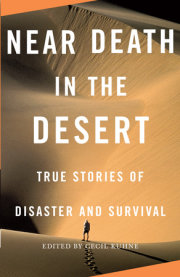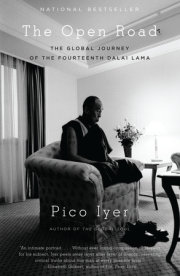1
The Nun’s Tale
Two hills of blackly gleaming granite, smooth as glass, rise from a thickly wooded landscape of banana plantations and jagged palmyra palms. It is dawn. Below lies the ancient pilgrimage town of Sravanabelagola, where the crumbling walls of monasteries, temples and
dharamsalas cluster around a grid of dusty, red earth roads. The roads converge on a great rectangular tank. The tank is dotted with the spreading leaves and still-closed buds of floating lotus flowers. Already, despite the early hour, the first pilgrims are gathering.
For more than 2,000 years, this Karnatakan town has been sacred to the Jains. It was here, in the third century bc, that the first Emperor of India, Chandragupta Maurya, embraced the Jain religion and died through a self-imposed fast to the death, the emperor’s chosen atonement for the killings for which he had been responsible in his life of conquest. Twelve hundred years later, in ad 981, a Jain general commissioned the largest monolithic statue in India, sixty feet high, on the top of the larger of the two hills, Vindhyagiri.
This was an image of another royal Jain hero, Prince Bahubali. The prince had fought a duel with his brother Bharata for control of his father’s kingdom. But in the very hour of his victory, Bahubali realised the folly of greed and the transience of worldly glory. He renounced his kingdom and embraced instead the path of the ascetic. Retreating to the jungle, he stood in meditation for a year, so that the vines of the forest curled around his legs and tied him to the spot. In this state he conquered what he believed to be the real enemies—his passions, ambitions, pride and desires—and so became, according to the Jains, the first human being to achieve
moksha, or spiritual liberation.
The sun has only just risen above the palm trees, and an early morning haze still cloaks the ground. Yet already the line of pilgrims—from a distance, tiny ant-like creatures against the dawn-glistening fused-mercury of the rock face—are climbing the steps that lead up to the monumental hilltop figure of the stone prince. For the past thousand years this massive broad-shouldered statue, enclosed in its lattice of stone vines, has been the focus of pilgrimage in this Vatican of the Digambara, or Sky Clad Jains.
Digambara monks are probably the most severe of all India’s ascetics. They show their total renunciation of the world by travelling through it completely naked, as light as the air, as they conceive it, and as clear as the Indian sky. Sure enough, among the many ordinary lay people in lungis and saris slowly mounting the rock-cut steps are several completely naked men—Digambara monks on their way to do homage to Bahubali. There are also a number of white-clad Digambara nuns, or
matajis, and it was in a temple just short of the summit that I first laid eyes on Prasannamati Mataji.
I had seen the tiny, slender, barefoot figure of the nun in her white sari bounding up the steps above me as I began my ascent. She climbed quickly, with a pot of water made from a coconut shell in one hand, and a peacock fan in the other. As she climbed, she gently wiped each step with the fan in order to make sure she didn’t stand on, hurt or kill a single living creature on her ascent of the hill: one of the set rules of pilgrimage for a Jain
muni, or ascetic.
It was only when I got to the Vadegall Basadi, the temple which lies just below the summit, that I caught up with her—and saw that despite her bald head Mataji was in fact a surprisingly young and striking woman. She had large, wide-apart eyes, olive skin and an air of self-contained confidence that expressed itself in a vigour and ease in the way she held her body. But there was also something sad and wistful about her expression as she went about her devotions; and this, combined with her unexpected youth and beauty, left one wanting to know more.
Mataji was busy with her prayers when I first entered the temple. After the glimmering half-light outside, the interior was almost completely black, and it took several minutes for my eyes fully to adjust to the gloom. At the cardinal points within the temple, at first almost invisible, were three smooth, black marble images of the Jain
Tirthankaras, or Liberators. Each was sculpted sitting Buddha-like in the
virasana samadhi, with shaved head and elongated earlobes. The hands of each
Tirthankara was cupped, and they sat cross-legged in a lotus position, impassive and focused inwards, locked in the deepest introspection and meditation.
Tirthankara means literally “ford-maker,” and the Jains believe these heroic ascetic figures have shown the way to Nirvana, making a spiritual ford through the rivers of suffering, and across the wild oceans of existence and rebirth, so as to create a crossing place between
samsara and liberation.
To each of these figures in turn, Mataji bowed. She then took some water from the attendant priest and poured it over the hands of the statues. This water she collected in a pot, and then used it to anoint the top of her own head. According to Jain belief, it is good and meritorious for pilgrims to express their devotion to the
Tirthankaras, but they can expect no earthly rewards for such prayers: as perfected beings, the ford-makers have liberated themselves from the world of men, and so are not present in the statues in the way that, say, Hindus believe their deities are incarnate in temple images. The pilgrim can venerate, praise, adore and learn from the example of the
Tirthankaras, and they can use them as a focus for their meditations. But as the ford-makers are removed from the world they are unable to answer prayers; the relationship between the devotee and the object of his devotion is entirely one way. At its purest, Jainism is almost an atheistic religion, and the much venerated images of the
Tirthankaras in temples represent not so much a divine presence as a profound divine absence.
I was intrigued by Mataji’s intense dedication to the images, but as she was deep in her prayers, it was clear that now was not the moment to interrupt her, still less to try to talk to her. From the temple, she headed up the hill to wash the feet of Bahubali. There she silently mouthed her morning prayers at the feet of the statue, her rosary circling in her hand. Then she made five rounds of the
parikrama pilgrim circuit around the sanctuary, and as quickly as she had leapt up the steps, she headed down them again, peacock fan flicking and sweeping each step before her.
It was only the following day that I applied for, and was given, a formal audience—or as the monks called it,
darshan—with Mataji at the monastery guest house; and it was only the day after that, as we continued our conversations, that I began to learn what had brought about her air of unmistakable melancholy.
“We believe that all attachments bring suffering,” said Prasannamati Mataji, after we had been talking for some time. “This is why we are supposed to give them up. It is one of the main principles of Jainism—we call it
aparigraha. This was why I left my family, and why I gave away my wealth.”
We were talking in the annex of a monastery prayer hall, and Mataji was sitting cross-legged on a bamboo mat, raised slightly above me on a low dais. The top of her white sari was now modestly covering her plucked head. “For many years, I fasted, or ate at most only once a day,” she continued. “Like other nuns, I often experienced hunger and thirst. I tried to show compassion to all living creatures, and to avoid all forms of violence, passion or delusion. I wandered the roads of India barefoot.” As she said this, the nun ran a hand up the hard and callused sole of her unshod foot. “Every day I suffered the pain of thorns and blisters. All this was part of my effort to shed my last attachments in this illusory world.
“But,” she said, “I still had one attachment—though of course I didn’t think of it in that way.”
“What was that?” I asked.
“My friend Prayogamati,” she replied. “For twenty years we were inseparable companions, sharing everything. For our safety, we Jain nuns are meant to travel together, in groups or in pairs. It never occurred to me that I was breaking any of our rules. But because of my close friendship with her, I formed not just an attachment, but a strong attachment—and that left an opening for suffering. But I only realised this after she died.”
There was a pause, and I had to encourage Mataji to continue. “In this stage of life we need company,” she said. “You know, a companion with whom we can share ideas and feelings. After Prayogamati left her body, I felt this terrible loneliness. In truth, I feel it to this day. But her time was fixed. When she fell ill—first with TB and then malaria—her pain was so great she decided to take
sallekhana, even though she was aged only thirty-six.”
“Sallekhana?”
“It’s the ritual fast to the death. We Jains regard it as the culmination of our life as ascetics. It is what we all aim for, and work towards as the best route to Nirvana. Not just nuns—even my grandmother, a lay person, took
sallekhana.”
“You are saying she committed suicide?”
“No, no:
sallekhana is not suicide,” she said emphatically. “It is quite different. Suicide is a great sin, the result of despair. But
sallekhana is as a triumph over death, an expression of hope.”
“I don’t understand,” I said. “If you starve yourself to death, then surely you are committing suicide?”
“Not at all. We believe that death is not the end, and that life and death are complementary. So when you embrace
sallekhana you are embracing a whole new life—it’s no more than going through from one room to another.”
“But you are still choosing to end your life.”
“With suicide, death is full of pain and suffering. But
sallekhana is a beautiful thing. There is no distress or cruelty. As nuns our lives are peaceful, and giving up the body should also be peaceful. You have the
Tirthankaras’ names on your lips, and if you do it slowly and gradually, in the prescribed way, there is no pain; instead there is a gentle purity in all the privations.
“At all stages you are guided by an experienced
mataji or guru. Everything is planned long in advance—when, and how, you give up your food. Someone is appointed to sit with you and look after you at all times, and a message is sent out to all members of the community that you have decided to take this path. First you fast one day a week, then you eat only on alternate days: one day you take food, the next you fast. One by one, you give up different types of food. You give up rice, then fruits, then vegetables, then juice, then buttermilk. Finally you take only water, and then you have that only on alternate days. Eventually, when you are ready, you give up that too. If you do it very gradually, there is no suffering at all. The body is cooled down, so that you can concentrate inside on the soul, and on erasing all your bad karma.
“At every stage you are asked: are you prepared to go on, are you sure you are ready for this, are you sure you don’t want to turn back? It is very difficult to describe, but really it can be so beautiful: the ultimate rejection of all desires, the sacrificing of everything. You are surrounded, cradled, by your fellow monks. Your mind is fixed on the example of the
Jinas.”
She smiled. “You have to understand that for us death is full of excitement. You embrace
sallekhana not out of despair with your old life, but to gain and attain something new. It’s just as exciting as visiting a new landscape or a new country: we feel excited at a new life, full of possibilities.”
I must have looked surprised, or unconvinced, because she stopped and explained what she meant using the simplest images. “When your clothes get old and torn,” she said, “you get new ones. So it is with the body. After the age of thirty, every year it becomes weaker. When the body withers completely, the soul will take a new one, like a hermit crab finding a new shell. For the soul will not wither, and in rebirth you simply exchange your torn and damaged old clothes for a smart new suit.”
“But you could hardly have felt excited when your friend left you like this.”
“No,” she said, her face falling. “It is hard for those who are left.”
She stopped. For a moment Mataji lost her composure; but she checked herself.
“After Prayogamati died, I could not bear it. I wept, even though we are not supposed to. Any sort of emotion is considered a hindrance to the attainment of Enlightenment. We are meant to cultivate indifference—but still I remember her.”
Again her voice faltered. She slowly shook her head. “The attachment is there even now,” she said. “I can’t help it. We lived together for twenty years. How can I forget?”
Jainism is one of the most ancient religions of the world, similar to Buddhism in many respects, and emerging from the same heterodox classical Indian world of the Ganges basin in the early centuries bc. Like Buddhism, it was a partly a reaction to Brahminical caste consciousness and the readiness of the Brahmins to slaughter huge quantities of animals for temple sacrifices—but the faith of the Jains is slightly more ancient, and much more demanding than Buddhist practice. Buddhist ascetics shave their heads; Jains pluck their hair out by the roots. Buddhist monks beg for food; Jains have to have their food given to them without asking. All they can do is to go out on
gowkari—the word used to describe the grazing of a cow—and signal their hunger by curving their right arm over their shoulder. If no food comes before the onset of the night, they go to bed hungry. They are forbidden to accept or in any way handle money.
In ancient India, the Jain monks were also celebrated for their refusal to wash, and like the Coptic monks of Egypt, equated a lack of concern for outward appearance with inner purity. One early inscription at Sravanabelagola admiringly refers to a monk so begrimed with filth that “he looked as if he wore a closely fitting suit of black armour.” Today the monks are allowed to wipe themselves with a wet towel and to wash their robes every few weeks; but bathing in ponds or running water or the sea is still strictly forbidden, as is the use of soap.
Unlike Buddhism, the Jain religion never spread beyond India, and while it was once a popular and powerful faith across the subcontinent, patronised by the princes of a succession of Deccani dynasties, today there are only four million Jains left, and these are largely limited to the states of Rajasthan, Gujarat, Madhya Pradesh and Karnataka. Outside India, the religion barely exists, and in contrast to Buddhism, is almost unknown in the West.
The word Jain derives from
Jina, meaning liberator or spiritual conqueror. The
Jinas or
Tirthankaras—ford-makers—were a series of twenty-four human teachers who each discovered how to escape the eternal cycle of death and rebirth. Through their heroic
tapasya—bodily austerities—they gained omniscient and transcendent knowledge which revealed to them the nature of the reality of the great theatre of the universe, in every dimension. The most recent of those, according to the Jains, was the historical figure of Mahavira (599–529 bc)—the Great Hero—a prince of Magadha, in modern Bihar, who renounced the world at the age of thirty to become a wandering thinker and ascetic.
Mahavira elaborated to his followers a complex cosmological system that the Jains still expound 2,600 years later. Like follower’s of other Indian faiths they believe in an immortal and indestructible soul, or
jivan, and that the sum of one’s actions determines the nature of one’s future rebirth. However, the Jains diverge from Hindus and Buddhists in many ways. They reject the Hindu idea that the world was created or destroyed by omnipotent gods, and they mock the pretensions of the Brahmins, who believe that ritual purity and temple sacrifices can bring salvation. As a Jain monk explains to a group of hostile Brahmins in one of the most ancient Jain scriptures, the most important sacrifice for Jains is not some
puja, or ritual, but the sacrifice of one’s own body: “Austerity is my sacrifical fire,” says the monk, “and my life is the place where the fire is kindled. Mental and physical effort are my ladle for the oblation, and my body is the dung fuel for the fire, my actions my firewood. I offer up an oblation praised by the wise seers consisting of my restraint, effort and calm.”
Crucially, the Jains differ from both Hindus and Buddhists in their understanding of karma, which for other faiths means simply the fruit of your actions. Jains, however, conceive of karma as a fine material substance that physically attaches itself to the soul, polluting and obscuring its potential for bliss by weighing it down with pride, anger, delusion and greed, and so preventing it from reaching its ultimate destination at the summit of the universe. To gain final liberation, you must live life in a way that stops you accumulating more karma, while wiping clean the karma you have accumulated in previous lives. The only way to do this is to embrace an ascetic life and to follow the path of meditation and rigorous self-denial taught by the
Tirthankaras. You must embrace a life of world renunciation, non-attachment and an extreme form of non-violence.
The soul’s journey takes place in a universe conceived in a way that is different from that of any other faith. For Jains, the universe is shaped like a gigantic cosmic human body. Above the body is a canopy containing the liberated and perfected souls—siddhas—who, like the
Tirthankaras, have escaped the cycle of rebirths. At the top of the body, level with the chest, is the celestial upper world, the blissful home of the gods.
At waist level is the middle world, where human beings live in a series of concentric rings of land and ocean. The central landmass of this world—the continent of the Rose Apple Tree—is bounded by the mighty Himalayas, and set within ramparts of diamonds. At its very centre, the
axis mundi, lies the divine sanctuary of the Jinas, Mount Meru, with its two suns and two moons, its parks and woods and its groves of wish-granting trees. Adjacent to this, but slightly to the south, lies the continent of Bharata or India. Here can be found the great princely capitals, surrounded by ornamental lakes blooming with lotus flowers.
Below this disc lies the hell world of the Jains. Here souls who have committed great sins live as hell beings in a state of terrible heat, unquenchable thirst and endless pain, under the watch of a group of malignant and semi-divine jailers, the
asuras, who are strongly opposed to the dharma of the
Tirthankaras.
In this world, there are no creator gods: depending on its actions and karma, a soul can be reincarnated as a god, but eventually, when its store of merit is used up, the god must undergo the agonies of death and fall from heaven, to be reborn as a mortal in the middle world. The same is true of hell beings. Once they have paid through suffering for their bad actions, they can rise to be reborn in the middle world and again begin the cycle of death and rebirth—depending on their karma, as human beings, animals, plants or tiny unseen creatures of the air. Like the fallen gods, former hell beings can also aspire to achieving
moksha, the final liberation of the soul from earthly existence and suffering. Even the
Tirthankara Mahavira, the Great Hero himself, spent time as a hell being, and then as a lion, before rising to be a human and so finding the path to Enlightenment. It is only human beings—not the hedonistic gods—who can gain liberation, and the way to do this is completely to renounce the world and its passions, its desires and attachments, and to become a Jain ascetic. As such, the monk or nun must embrace the Three Jewels, namely right knowledge, right faith and right conduct, and to take five vows: no violence, no untruth, no stealing, no sex, no attachments. They wander the roads of India, avoiding any acts of violence, however small, and meditating on the great questions, thinking about the order and purpose of the universe, and attempting to ford the crossing places that lead through suffering to salvation. For the Jains, then, to be an ascetic is a higher calling than to be a god.
It is a strange, austere and in some ways very harsh religion; but that, explained Prasannamati Mataji, is exactly the point.
Copyright © 2010 by William Dalrymple. All rights reserved. No part of this excerpt may be reproduced or reprinted without permission in writing from the publisher.














































